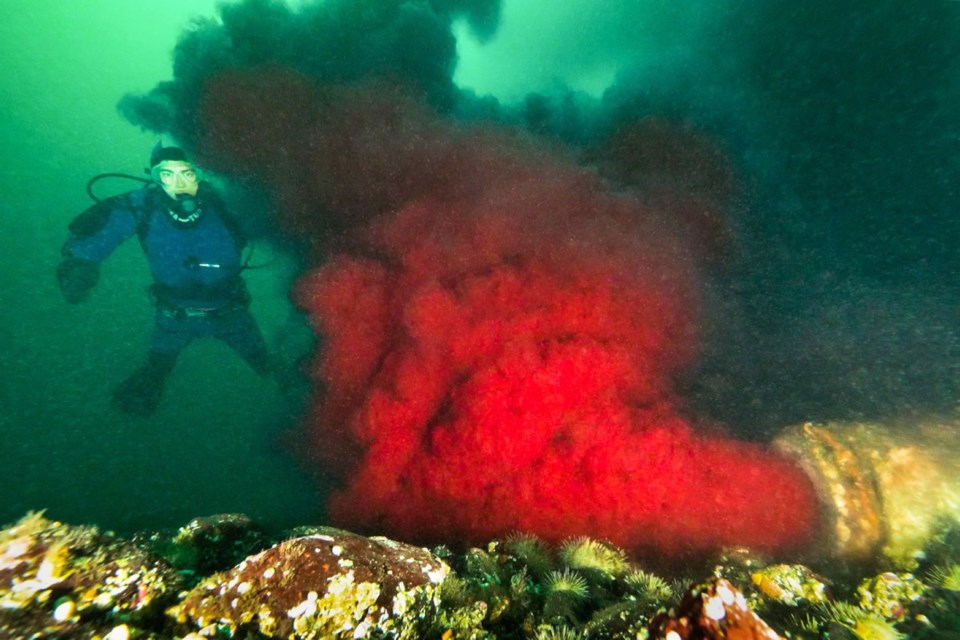Video of “blood water” being pumped into the ocean near Campbell River is prompting the province to take a look at the farmed-fish processing plant it came from.
The video, recorded by photographer Tavish Campbell, shows red effluent going into the water near the Browns Bay Packing Company, which processes farmed Atlantic salmon, at its plant near Campbell River.
Campbell said samples taken from the site were analyzed by the Atlantic Veterinary College and tested positive for piscine reovirus, or PRV, a highly contagious virus that most farmed salmon carry. The virus has been linked to a disease — heart and skeletal muscular disease (HSMI) — that makes fish lethargic and more vulnerable to predation.
Environment Minister George Heyman said the province will send an inspector to visit the packing plant in the next few days.
The plant hasn’t been inspected since 2013 and many plants in B.C. are operating on permit standards set decades ago, Heyman said.
“We are in the process of reviewing what is happening at that particular plant,” he said.
“British Columbians really expect us to keep our water safe and protect our wild salmon, so that’s our intent. We want to ensure, as we review the permit and put conditions on the permit as necessary, that any discharge into the water is safe and does not contaminate wild salmon.”
The province is also reviewing the test results of the effluent and may conduct its own tests, he said.
In a statement on its website, Browns Bay Packing Co. said it disinfects effluent before releasing it into the marine environment, like all plants processing farmed Atlantic salmon.
“While the liquid discharge remains red in colour, the treatment process is designed specifically to treat pathogens,” the statement said.
It treats effluent at a higher level than the provincial standard, which requires a functional disinfection system for all wastewater, it said.
The company has a Global Aquaculture Alliance’s Best Aquaculture Practices certification.
Campbell said he doesn’t believe the plant is doing anything illegal, and would like to see greater regulation of the industry.
“We’re not trying to demonize a rogue processor, one rogue plant. This more points to the fact that the Department of Fisheries and Oceans really isn’t managing wild salmon at all,” he said.
Campbell said he saw effluent coming from an outflow pipe extending about 85 feet from the Browns Bay Packing Company near Campbell River.
Browns Bay sits at a bottleneck in the Discovery Passage, he said, which is a migration route for wild salmon.
“At the end of the pipe, it was just billowing with deep red blood water,” he said. “My underwater camera lights illuminated the blood in such a way that it was shimmering with scales, so there were tons of little chunks of blood and scales and small pieces of offal mixed in there.”
It is unclear how contagious PRV is when active in blood water. However, independent biologist Alexandra Morton said the virus can survive a long time outside of fish.
“It’s a durable virus,” she said.
Jeremy Dunn, executive director for the B.C. Salmon Farmers Association, said effluent is treated for pathogens, but not specifically PRV.
The treatment was designed to combat another virus — infectious hematopoietic virus (IHN), a pathogen that was problematic in 2009 and 2010. All farmed Atlantic salmon are now vaccinated against IHN.
The industry has made other improvements, he said. In 2011, it began treating blood water and wastewater that came from the loading and transporting of fish. That water was previously discharged untreated.
Dunn said there’s no way to know that the PRV in the samples came from the fish blood, rather than the ocean water collected, since the virus has been known to exist in both. “Is the PRV in their sample coming from the plant or the ocean? I can’t know that.”
Federal Fisheries Minister Dominic LeBlanc said officials at Environment and Climate Change Canada are studying the video to determine whether violations have occurred and will take action as necessary.
LeBlanc contacted Heyman Nov. 9, after seeing the video, to ensure that provincial and federal regulations are in line to protect fish and fish habitat, he said in a statement.
“The health of our oceans is a priority for our government and we take any potential risks to wild fish, including Pacific salmon, very seriously,” LeBlanc said.



